
Drag racing is a type of motor racing in which automobiles or motorcycles compete, usually two at a time, to be first to cross a set finish line. The race follows a short, straight course from a standing start over a measured distance, most commonly 1⁄4 mi, with a shorter, 1,000 ft distance becoming increasingly popular, as it has become the standard for Top Fuel dragsters and Funny Cars, where some major bracket races and other sanctioning bodies have adopted it as the standard. The 1⁄8 mi is also popular in some circles. Electronic timing and speed sensing systems have been used to record race results since the 1960s.

A dragstrip is a facility for conducting automobile and motorcycle acceleration events such as drag racing. Although a quarter mile is the best known measure for a drag track, many tracks are eighth mile (201 m) tracks, and the premiere classes will run 1,000 foot (304.8 m) races. The race is begun from a standing start which allows three factors to affect the outcome of the race: reaction time, power/weight ratio, and traction.
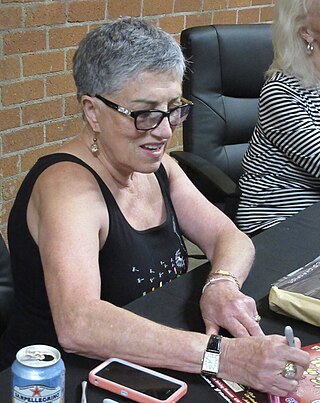
Shirley Muldowney, also known professionally as "Cha Cha" and the "First Lady of Drag Racing", is an American auto racer. She was the first woman to receive a license from the National Hot Rod Association (NHRA) to drive a Top Fuel dragster. She won the NHRA Top Fuel championship in 1977, 1980, and 1982, becoming the first person to win two and three Top Fuel titles. She won a total of 18 NHRA national events.
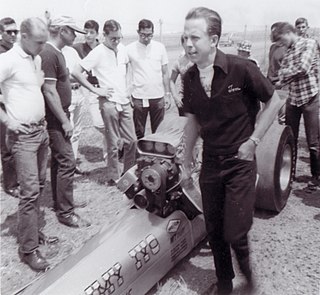
Tommy Ivo, also known as "TV Tommy" and "Instant Ivo" is an actor and drag racer, who was active in the 1960s racing community.
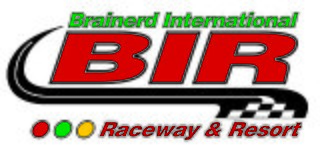
Brainerd International Raceway is a road course, and dragstrip racing complex northwest of the city of Brainerd, Minnesota. The complex has a 0.25 mi (0.40 km) dragstrip, and overlapping 2.500 mi (4.023 km) and 3.100 mi (4.989 km) road courses. The complex also includes a kart track. The raceway hosts the National Hot Rod Association's Lucas Oil Nationals. It is a popular racetrack for the Trans Am Series. The spectator seating capacity of the circuit is 20,000.

Route 66 Raceway is a motorsports facility located in Joliet, Illinois, United States. It consists of a 0.25-mile (0.40 km) dragstrip and a 0.375-mile (0.604 km) dirt oval racetrack. The facility is owned and operated by NASCAR and is located adjacent to Chicagoland Speedway.
Great Lakes Dragway is a quarter mile dragstrip in the Town of Paris, Kenosha County, near Union Grove, Wisconsin.

The Pomona Raceway, is a racing facility located in Pomona, California that features a quarter-mile dragstrip. Since its opening in 1961, the dragstrip has hosted the NHRA's Winternationals event – the traditional season opener – and since 2021, the season's last race, the NHRA Finals. These two events have contributed to its becoming perhaps one of the most famous dragstrips in North America. The facility has a seating capacity of 40,000 spectators, and it is one of the few dragstrips in the USA that is operated directly by the NHRA. This dragstrip has also gone by the nickname of The Fairplex, in reference to its location at the Fairplex, formerly called the Los Angeles County Fairgrounds.
Old Bridge Township Raceway Park, originally known as Madison Township Raceway Park, is an American auto racing facility located in Old Bridge Township, in Middlesex County, New Jersey, United States.

Hilo Dragstrip is a dragstrip located just southeast of Hilo, Hawaii at 19°40′53″N155°1′49″W. It is also called the Pana‘ewa Drag Strip. Hilo dragstrip opened in 1978, and is now operated by the County of Hawaiʻi. The Big Island Auto Club and the Hawaii Drag Racing League race at the strip. The biggest race events at the Hilo Drag Strip are the BIAC Memorial Day Drags and the BIAC Tommy Thompson Labor Day Drags. The track is sanctioned by the International Hot Rod Association (IHRA) (HDRL) and American Hot Rod Association (AHRA) (BIAC) International Hot Rod Motocross and kart racing tracks.
Orange County International Raceway was a combined 1⁄4-mile US dragstrip and 2-mile road course, plus a motocross track, located in Irvine, California adjacent to the Interstate 5 (I-5) Santa Ana Freeway. Under a lease agreement with the Irvine Company, OCIR – as it was known in racing circles – was in operation from August 5, 1967, until its closure on October 30, 1983. The track was so named because its founders envisioned hosting sports car, motorcycle, midget, and stock car races in addition to National Hot Rod Association (NHRA) sanctioned drag racing events.

Tom McEwen was an American drag racer who was a winner of the National Hot Rod Association (NHRA) U.S. Nationals. His racing career spanned 45 years. He is ranked at number 16 on a list of the 50 most significant drivers of NHRA’s first 50 years.
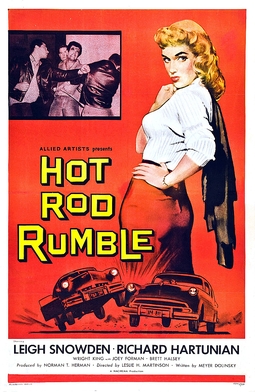
Hot Rod Rumble is a US, low budget, black-and-white 1957 teen-oriented drag racing crime drama produced by Norman T. Herman and directed by Leslie H. Martinson. It stars Leigh Snowden and Richard Hartunian. The film tells the story of a clash within the Road Devils hot rod club when some of its members jump to a wrong conclusion following the accidental death of one of them in a car crash.

Fred Essler was an American actor. He worked film, television and on stage.

Dragstrip Girl is a 1957 film starring John Ashley in his first lead role. American International Pictures released the film as a double feature with Rock All Night and it proved an early success for the studio.

1950s American automobile culture has had an enduring influence on the culture of the United States, as reflected in popular music, major trends from the 1950s and mainstream acceptance of the "hot rod" culture. The American manufacturing economy switched from producing war-related items to consumer goods at the end of World War II, and by the end of the 1950s, one in six working Americans were employed either directly or indirectly in the automotive industry. The United States became the world's largest manufacturer of automobiles, and Henry Ford's goal of 30 years earlier—that any man with a good job should be able to afford an automobile—was achieved. A new generation of service businesses focusing on customers with their automobiles came into being during the decade, including drive-through or drive-in restaurants and greatly increasing numbers of drive-in theaters (cinemas).
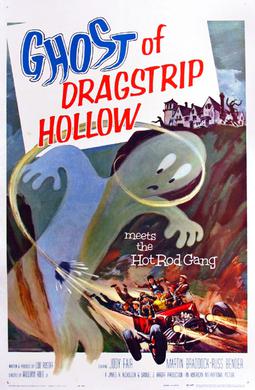
Ghost of Dragstrip Hollow is a 1959 AIP horror comedy film. It was a sequel to their film Hot Rod Gang. American International Pictures released the film in July 1959 as a double feature with Diary of a High School Bride.
Roberta Maxine Leighton was an American drag racer. She was the first woman licensed by the National Hot Rod Association (NHRA) to race competitively. She was also the first woman to win a national title, in the 1962 U.S. Nationals at Indianapolis, in the J/S class. In 2002, shortly before her death, she received a lifetime achievement award at the World Finals at Pomona.
Doug Thorley was an American Funny Car drag racer, hot rodder and businessman. In 1967, he won the NHRA Nationals' first Funny Car Eliminator title, and was given Car Craft's All-Star Drag Racing Team Funny Car Driver of the Year Award in 1968. Hot Rod magazine describes him as "one of drag racing's most famous early era drivers."
Steve Reyes is an American photographer and storyteller from Oakland, California. Reyes has been included in Don Garlits' International Drag Racing Hall of Fame (2002), NHRA California Hot Rod Reunion Honorees (2009), and the East Coast Drag Times Hall of Fame (2011).

















